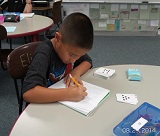Gail Boushey
At two and a half years old, our granddaughter Hadley is asking a lot of questions. “Why is it raining? Why is my brother crying? What are you doing?” Answering Hadley’s questions requires a lot of thought on our part, and we often find ourselves asking questions of her in return. Lately, when we ask Hadley questions, she responds with ”You tell me” and waits until she can agree with our response.
 “Hadley, who did you see today?”
“Hadley, who did you see today?”
“You tell me.”
“Hadley, where did you go today?”
“You tell me.”
“Hadley, what did you play today?”
“You tell me.”
It is fascinating to hear Hadley turn our questions back to us, as if she doesn’t see any reason to give us an answer that we already know. How often does this happen in our classes, especially with students who may be a little more school savvy? We have students who are willing to play the game of answering these lower-order questions, even when they know we already know the answer. We can do better.
Questions can be categorized in many different ways—from Bloom’s taxonomy to Ted Wragg’s empirical, conceptual, and value questions, to Taffy Rafael’s Question Answer Relationship. However, all of these approaches include a basic differentiation between lower-order and higher-order questions. Lower-order questions usually start with who, what, when, or where. Relying on basic recall, children can answer such questions with a single right answer. In contrast, higher-order questions, which may begin with how, why, and which, are important because they require children to think.
Teachers ask between three and four hundred questions each day, well over 60 percent of which fall into the lower-order category. Many of our questions are organizational tools used to check the completion of work, summarize what has been taught, and evaluate whether learning has occurred. Our higher-level questions have the added potential to motivate, develop thinking skills, and enhance knowledge. Strategies such as familiarizing ourselves with the different levels of questions, writing down a few “go-to” higher-order questions, and adding wait time when we ask them have considerable promise for improving classroom instruction and student learning.
From now on, I am going to take a note from Hadley and ask “Why?” more often—and then wait for a response.
News from The Daily CAFE
 Daily 5 . . .
Daily 5 . . .
Sample Schedules
These schedules will show you how fabulously flexible Daily 5 is.
 Math Matters . . .
Math Matters . . .
Math Writing Prompts: Starters for Successful Summaries*
These simple starters will help students formulate their thoughts so they can get them on paper.

Story Corner . . .
Listen to Reading Websites
After you read this article you'll want to share, learn, and partake in the joyful collaboration happening on the discussion board.
 Focus on Health . . .
Focus on Health . . .
Morning Beginnings
Carol Moehrle reminds us that each day is a new beginning.





